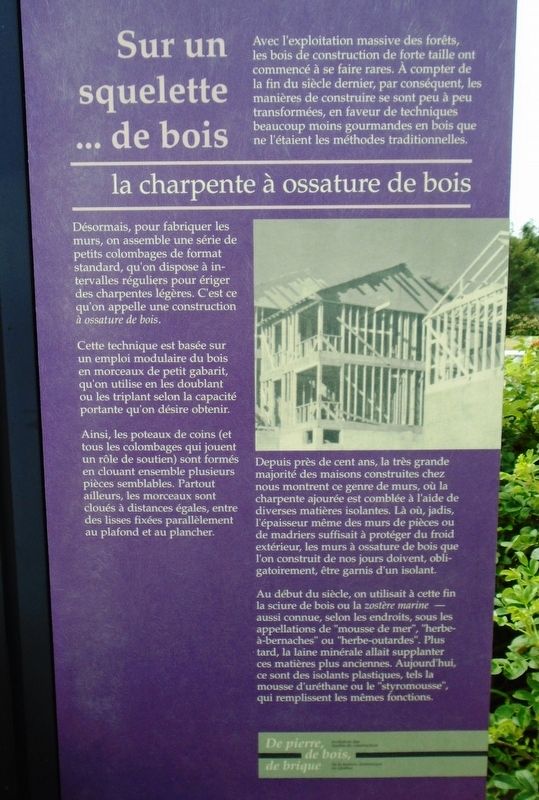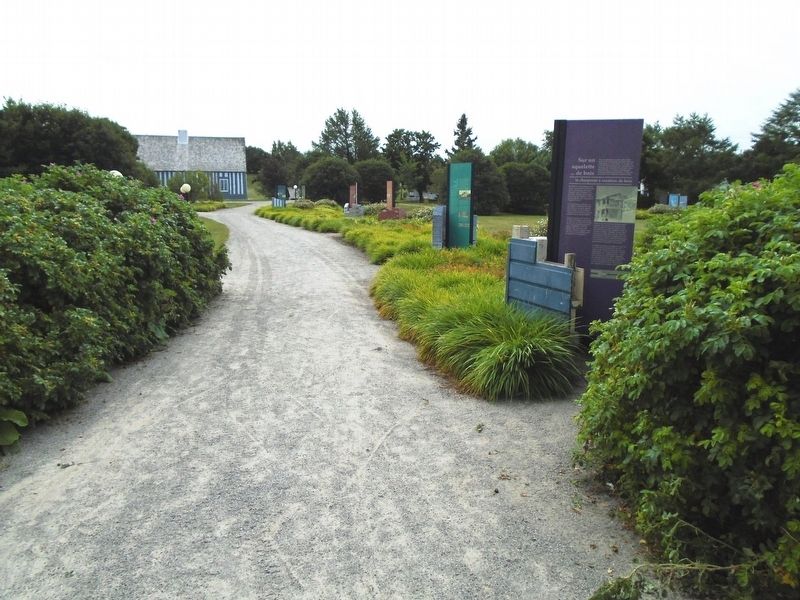Sur un squelette... de bois / On a skeleton... of wood
la charpente à ossature de bois / Wood Frame Framing
— De pierre, de bois, de brique / Stone, Wood, Brick —
Avec l'exploitation massive des forêts, les bois de construction de forte taille ont commencé à se faire rares. À compter de la fin du siècle dernier, par conséquent, les manières de construire se sont peu à peu transformées, en faveur de techniques beaucoup moins gourmandes en bois que ne l'étaient les méthodes traditionnelles.
Désormais, pour fabriquer les murs, on assemble une série de petits colombages de format standard, qu'on dispose à intervalles réguliers pour ériger des charpentes légères. C'est ce qu'on appelle une construction à ossature de bois.
Cette technique est basée sur un emploi modulaire du bois en morceaux de petit gabarit, qu'on utilise en les doublant ou les triplant selon la capacité portante qu'on désire obtenir.
Ainsi, les poteaux de coins (et tous les colombages qui jouent un rôle de soutien) sont formés en clouant ensemble plusieurs pièces semblables. Partout ailleurs, les morceaux sont cloués à distances égales, entre des lisses fixées parallèlement au plafond et au plancher.
Depuis près de cent ans, la très grande majorité des maisons construites chez nous montrent ce genre de
murs, où la charpente ajourée est comblée à l'aide de diverses matières isolantes. Là où, jadis, l'épaisseur même des murs de pièces ou de madriers suffisait à protéger du froid extérieur, les murs à ossature de bois que l'on construit de nos jours doivent, obligatoirement, être garnis d'un isolant.Au début du siècle, on utilisait à cette fin la sciure de bois ou la zostère marine - aussi connue, selon les endroits, sous les appellations de "mousse de mer", "herbe-à-bernaches" ou "herbe-outardes". Plus tard, la laine minérale allait supplanter ces matières plus anciennes. Aujourd'hui, ce sont des isolants plastiques, tels la mousse d'uréthane ou le "styromousse", qui remplissent les mêmes fonctions.
With the massive exploitation of forests, large timber started to become scarce. From the end of the last [19th] century, therefore, building methods have gradually been transformed in favor of techniques much less wood greedy than traditional methods.
Today, to make the walls, we assemble a series of small half-timberings of standard size, which are placed at regular intervals to erect light frameworks. This is called a wood frame construction.
This technique is based on a modular use of small pieces of lumber, which is used by doubling or tripling them according to the load-bearing capacity desired.
Thus,
For almost a hundred years, the vast majority of houses built here have been showing such walls, where the openwork frame is filled with various insulating materials. Where once, the thickness of the walls of rooms or planks was enough to protect from outside cold, wood-frame walls that are built today must, necessarily, be lined with insulation.
At the beginning of the century, sawdust or eelgrass - also known, depending on the area, as "sea moss," "grass-geese," or "grass-bustards" - was used for this purpose. Later, mineral wool would supplant these older materials. Today, plastic insulators, such as urethane foam or "styrofoam," perform the same functions.
In general, we used pine or spruce planks with a standard gauge (approximately 8cm x 30cm: 3" thick and 12" to 15" wide), but sometimes the plank was cut in two lengths to create a less thick wall.
Topics. This historical marker is listed in these topic lists: Architecture • Horticulture & Forestry • Settlements & Settlers.
Location. 48° 29.082′ N, 68° 29.734′ W. Marker is in
Other nearby markers. At least 8 other markers are within walking distance of this marker. Du moulin à la maison / From the mill to the house (here, next to this marker); Un jeu de blocs... d'argile / A set of blocks ... of clay (a few steps from this marker); Une forêt pour sa maison / A forest for his house (within shouting distance of this marker); La maison rurale en Nouvelle-France / The Rural House in New France (within shouting distance of this marker); Pierre des champs... pierre des villes / Stones of the fields... stones of the cities (within shouting distance of this marker); La maison urbaine en Nouvelle-France / The Urban House in New France (within shouting distance of this marker); La maison Londonienne / The London house (within shouting distance of this marker); Façons de France ...en Amérique / French Ways ...in America (within shouting distance of this marker). Touch for a list and map of all markers in Rimouski.
Regarding Sur un squelette... de bois / On a skeleton... of wood. Marker is one of a series highlighting the evolution of Quebec domestic architecture, titled, Stone, Wood, Brick.
Also see . . . Maison Lamontagne House Historic Site. (Submitted on November 26, 2018, by William Fischer, Jr. of Scranton, Pennsylvania.)
Credits. This page was last revised on January 20, 2020. It was originally submitted on November 25, 2018, by William Fischer, Jr. of Scranton, Pennsylvania. This page has been viewed 125 times since then and 6 times this year. Photos: 1, 2. submitted on November 25, 2018, by William Fischer, Jr. of Scranton, Pennsylvania.

